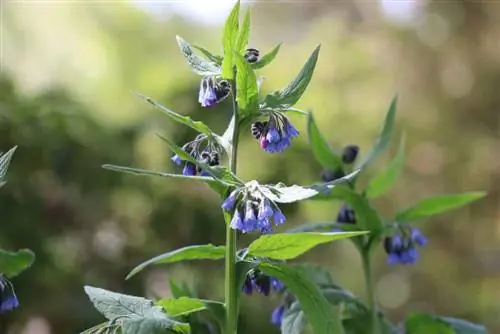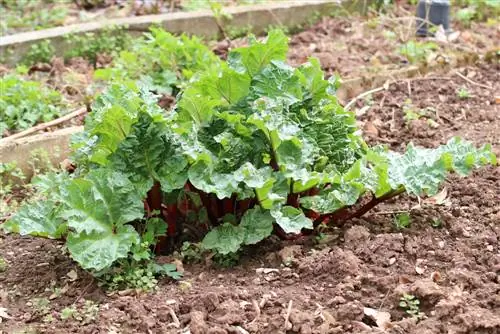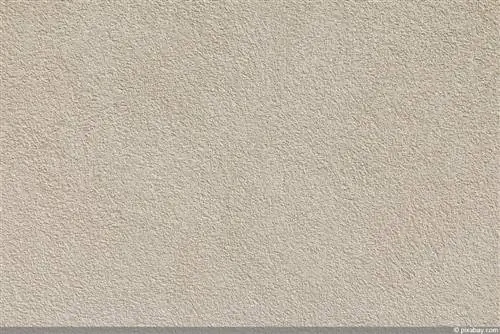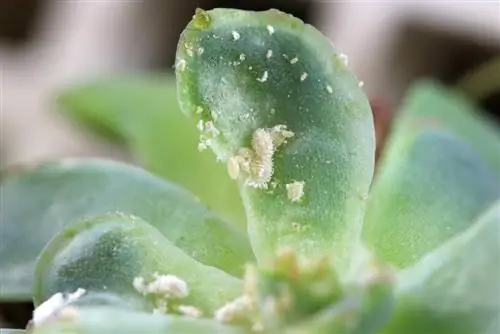- Author admin [email protected].
- Public 2023-12-17 03:39.
- Last modified 2025-01-24 12:45.
Comfrey, bot. Symphytum is a genus in the Boraginaceae family. There are about forty species distributed throughout Europe, North Africa and Central Asia. In this country, comfrey leaves are processed into comfrey manure and used as organic nitrogen fertilizer. As a medicinal plant, leaves and roots are used for ointments, porridge mixtures and tinctures, among other things.
Ingredients and application
Comfrey roots contain, among other things:
- essential oils
- tannins
- Choline
- Asparagine
- many minerals
- Proteins
- Vitamin B12
- Allantoin
Comfrey is mainly used because of the allantoin. Allantoin is very similar to urea, which is why comfrey is used for
- soothing the skin
- supporting cell structure
- stimulation of cell formation
- acceleration of cell regeneration
Comfrey ointment is also used for strains, sprains, sore muscles or torn tendons. In addition to these positive ingredients, pyrrolizidine alkaloids are also found in comfrey. In high doses, they are carcinogenic and liver-damaging because the breakdown of pyrrolizine alkaloids produces degradation products that are toxic to the liver. As a result, they lead to liver dysfunction and, in the worst case, liver occlusion.
Usage

Comfrey roots can be used fresh or dried. The most common forms of application include:
Fresh comfrey roots
- process pure or together with leaves into a paste and apply to the skin
- Pour juice from freshly pressed comfrey roots onto the root-forming areas of cuttings (should stimulate root formation)
Dried comfrey roots
- process into ointment or tincture
- use together with water as a poultice (also works with ground roots)
Comfrey Wrap
The simple way to relieve swelling with comfrey is a comfrey compress.100 grams of dried comfrey root are boiled with one liter of water. A piece of cotton fabric is then soaked in the still warm solution and placed on the swelling. Alternatively, mix the dried comfrey roots with three to four tablespoons of hot water until a thick paste is formed. This is then painted onto a piece of cotton fabric. The piece of fabric is then placed on the area to be treated. After two hours you should remove the poultice. You should also apply the poultice a maximum of three times a day (morning, lunch, evening). When using comfrey, it must be noted that it contains not only healing substances but also toxins. Since the toxins are not lost during drying, to avoid poisoning with pyrrolizine alkaloids you should
Always use comfrey in small doses
Use comfrey (plants and roots) for a maximum of four to six weeks at a time. Apply ointments or porridge mixtures only to intact skin (toxins must not enter the bloodstream)
Do not use comfrey for internal applications
Tip:
Comfrey ointments and other comfrey products should not be used by pregnant women, breastfeeding women or children under two years of age.
Harvesting
Comfrey roots are best harvested in autumn or spring. The ideal period is between October and April. Because roots are easier to remove from moist soil, you should harvest the roots after a rainy day. To get to the root, it has to be dug up. To do this, dig around the root with the shovel. Don't be surprised if the roots seem to have no end, because some magnificent specimens have roots up to 1.8 meters deep and are up to 50 centimeters long. Once the root has been dug up, it is simply pulled out of the soil. If it is stuck too firmly in the ground, you can help with a shovel.
Tip:
If you leave a piece of the root in the ground, new comfrey will grow from it.
Drying
Drying the comfrey root is very easy in and of itself. The root can be dried in the following places:
- in the oven
- in the dehydrator
- outdoor
- laid on an old, taut bed sheet in the apartment

The roots are dried at a very low temperature in the oven or dehydrator. A temperature between 40 and 60 degrees Celsius is ideal, and in no case higher. If the root is dried outdoors or in the apartment, then direct sunlight should be avoided. In order to speed up the drying process and ultimately make processing easier, the fresh comfrey root is cut into small pieces after it has been washed and cleaned. Whether you divide the root lengthwise or crosswise is up to you. If the root is divided, its white interior is visible under the black skin, which quickly turns brown when exposed to air. That's why the inside of the root is brown in color when dried.
Tip:
In order not to delay the drying process, the individual pieces should not lie on top of each other. Alternatively, you can string the root pieces on a string and hang them freely from the ceiling.
Although the roots are very easy to dry, there is a risk of mold formation when air drying because the roots contain a lot of water. That's why you should continuously monitor the process when drying in the open air. You should also dry the comfrey roots as quickly as possible because of their tendency to form mold.
Storage
Dried comfrey roots store well if they are
- cool
- dry
- dark and
- well closed
be stored. The shelf life is then around twelve months. Homemade ointments must not be stored in metal containers, as allantoin breaks down very quickly when it comes into contact with metal. Tinctures made from comfrey roots last up to two years at room temperature in a place protected from light.






